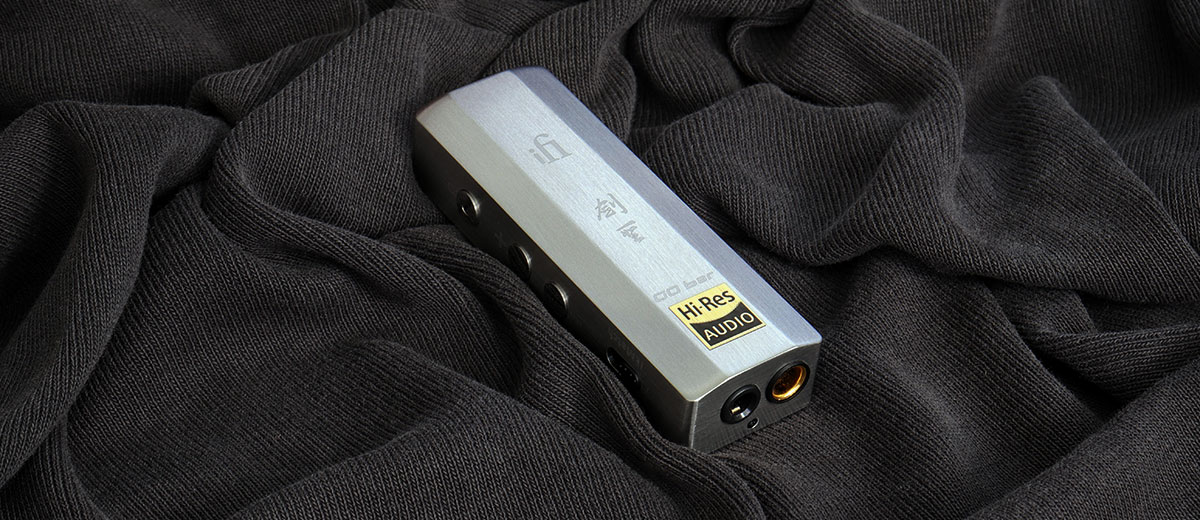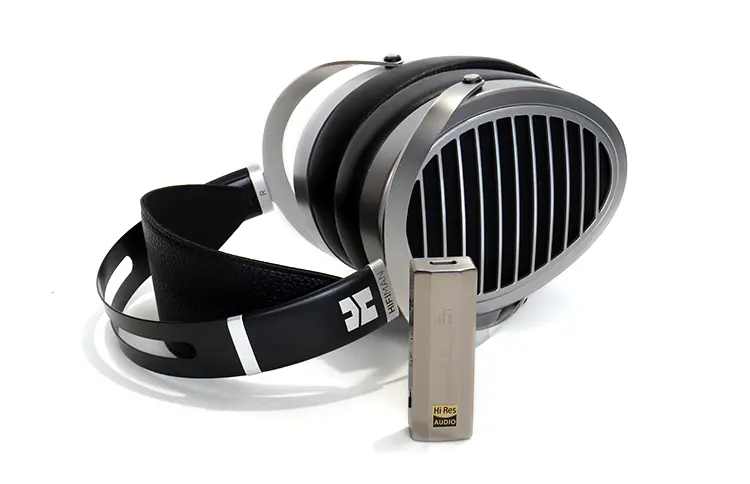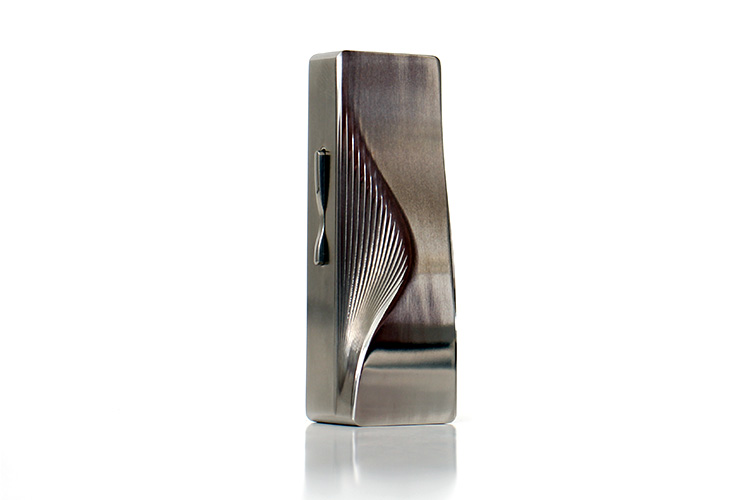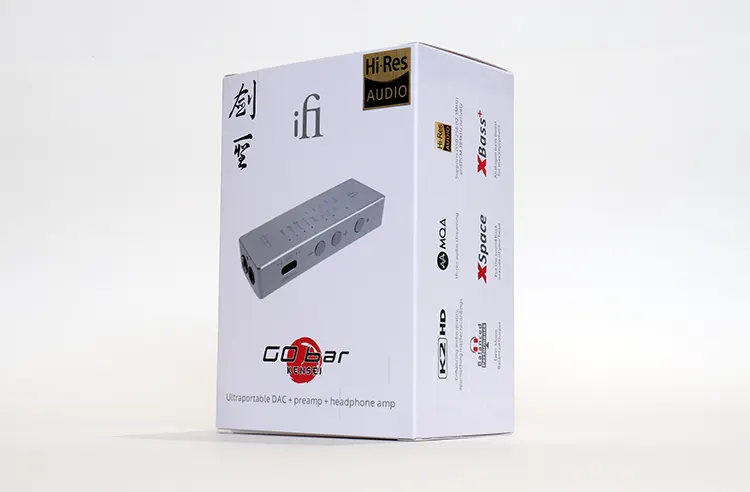Synergy
Power
The iFi Audio GO bar Kensei output is beefy enough to power many headphones that are not easy to drive to loud levels. I was able to push my HE400se to extremely loud levels. The bass was not anemic in any sense either. The Sundara was another headphone that I could push to loud volume levels.
Dynamic headphones are even easier to push with the iFi Audio GO bar Kensei, even one like the SIVGA 023 which is a full-sized dynamic with a 300Ω rating.
Pairing
Pairing would depend on impedance and efficiency. I was able to use many IEMs like the FiiO FX15, and the ORIVETI OD200, and didn’t run into any issues until I used the ORIVETI OH700VB.
This pairing produced some funkiness in the form of high-frequency artifacts with the iFi Audio iDSD GRYPHON producing a better pairing.
The iFi Audio GO bar Kensei seems to like hard-to-drive headphones up to a certain point. The iEMatch feature is there to accommodate sensitive IEMs in conjunction with the standard gain. The turbo setting is certainly not the best setting for sensitive IEMs.
Select Comparisons
iFi Audio GO bar
Technical
The original iFi Audio GO bar has all the features of the Kensei except for the K2HD implementation alongside improved jitter elimination, and the beefed-up power supply section. The rest of the GO bar uses the same components.
The XMOS microcontroller seems the same variant. What also seems to be the same is the DAC section although we can’t be sure at this time since iFi has not disclosed what Cirrus Logic DAC they use in particular.
I was rather sure the original GO bar used the CS43131 but this one could have implemented the CS43198, and if that’s the case, this might give the Kensei more worth over the original GO Bar.
To be honest, there seems to be an improved DAC section within the Kensei so the above might be true. IFI needs to clarify what DAC is being used.
Design
The first thing I immediately noticed about both dongles was their considerable weight differences. Their weight sits at 28.5 grams and 65.5 grams. That’s 1 ounce versus 2.3 ounces. That means the Kensei is more than twice as heavy.
If you use either with their included holster, then their weight will not matter much but if you pocket carry, then the Kensei’s shell weight might bug you.
Other than that, and the color differences there’s not much to write about. Both models use the USB-C format input along with the dual headphone out jacks on the other end. The volume control buttons, the multifunction button, and the iEMatch placement have not changed either.
Every GO bar model has a total of nine LEDs on the back panel to indicate everything from bit rate, Xbass, and Xspace engagement, and the digital format playback status.
Performance
There’s a minuscule difference in power output here between these two. The original GO bar is rated at 475mW while the Kensei is rated at 477mW which in listening sessions is undetectable.
That means that the sonic differences will be heard differently due to the cleaner power supply section and the additional K2 feature because the rest stays the same.
The beefed-up power supply section does make a difference here in that the Kensei has a darker background but the cherry on top here is the K2 feature which serves up an organic transformation of the overall sonic presentation.
One number to look at is the SNR rating on the single-ended side. The Kensei raises the bar from the OG’s 108 dB to 121 dB rating. That specification improvement I bet is a final product of the upgraded power circuitry.
The sonic presentation is better focused, wider, and larger in scope on the Kensei. The K2HD feature lifts a veil off the original GO bar sonic signature and lets more detail come through.
Realism is increased almost two-fold with this technology and iFi Audio should certainly make this theirs and implement it on the rest of their future released gear.
Quloos QLS MC01
Technical
I like many things about the Quloos MC01 and it has a lot to offer. It’s a modern-day interpretation of a dongle DAC, especially aesthetic-wise.
The hardware list is not too bad but uses the now older CS43131 DAC. Quloos complements the dual DAC setup by including a couple of OPA6122 amplifier chips. The maximum power output is a more modest 260mW per side.
What stands out here is the display and the vast amount of features behind the OLED display. And although this dongle is feature-rich, there’s no MQA capability. There are five digital filters, one over the Kensei, yes, but the Kensei filters are audibly effective.
Design
The Quloos MC01 pocket carries well since it has no sharp edges and weight is kept below the Kensei’s heft. This dongle has channels and grooves alongside a curvy step design that gives it a look between industrial and artful simultaneously.
The screen is a nice touch but the Kensei implemented a system that the screen is not needed and neither a controlling app, which in this case, neither of these dongles includes a downloadable app.
The Quloos does have a 100-step volume control and although I could not solidly confirm it, the Kensei does have a precise volume control that lowers and raises the volume slowly, enough to supply enough control for the most sensitive IEMs.
Performance
Somehow, Quloos managed to tame some of the sharp characters of the CS43131 DAC chips and came up with a sonic presentation that is smooth and free from edginess and harshness. Some would consider the MC01 to be laid back and perhaps some would call it too relaxed.
There’s not much aggressiveness here and sound seems to come from an open field, more so than on the Kensei. But that makes it lose focus and the overall timbre is presented with a softer demeanor.
The MC01 does have a good amount of speediness and dynamism, but the Kensei portrays a better sense of realism and musicality.
Moondrop MoonRiver 2: TI
Technical
Strapped for cash? The Moondrop MoonRiver 2: TI might seem appealing to you considering that for a fraction of the Kensei’s cost, it has a set of updated CS43198 DACs plus a pair of LM6863D amplifiers in a four-channel configuration that is capable of producing 250mW per side.
Four digital filters are selectable within the Moondrop Link app that I could only find on Moondrop’s website. The app is a barebones app that is limited in features but to their credit, at least they have a working app up and running.
The MoonRiver 2 TI uses a CT7691 USB bridge from Comtrue instead of the XMOS components and one of the drawbacks is that the MoonRiver 2 TI can’t play MQA formats. However, it does well with PCM and DSD files.
Design
The MoonRiver 2 TI’s shell is a work of art. I wasn’t too crazy about the first MoonRiver 2 shell design but this one is gorgeous. However, just like the Kensei, it tends to pick up smudges often.
The MoonRiver 2 TI shell is CNC carved from a solid piece of TC4 Titanium with a pattern that Moondrop calls a ripping flow design.
It resembles a harp on a second look, and the rest of the body is polished except for the bottom plate which uses a sheet of glass allowing you to look at all the internal components.
Performance
Here’s another silver bullet that won’t slow you down. The Moondrop MoonRiver 2 TI has a sonic quality that displays fast transients, a smooth midsection, and highs that are accentuated and clean.
Sonically, the MoonRiver 2 TI has to be within the top ten nicest-sounding dongle DACs around regardless of price.
The dual CS43198 DAC chips did the trick and supplied a much-welcomed boost in detail production and improved harmonics over the original TI model.
The MoonRiver 2 TI’s dynamics are high, distortion is low, noise is minimal, and the overall sound signature is pleasing but there’s no versatility as far as sound shaping features.
There are four digital filters, yes, but are almost ineffective whereas the GO bar Kensei’s digital filters are effective and anyone can tell the differences they bring to the sound.
Alongside that, you get Xbass, Xspace, and the K2 feature, which is quickly becoming one of my favorite buttons to press. The phrase “you get what you pay for” applies here.
My Verdict
I considered the original iFi Audio GOLD bar the top dog among the dongle DAC I have reviewed to date but the iFi Audio GO bar Kensei is even better and is my new favorite dongle DAC.
The iFi Audio GO bar Kensei dongle DAC is a great purchase if your budget allows it, especially if you’re looking for a sound-quality first device within this segment.
iFi Audio is going to have to implement the K2HD feature on everything they release from now on. It makes a considerable difference in taking the Kensei version to a new sonic level.
It’s pricey and a bit heavy, but it will satisfy most ardent audiophiles. Sonically, it beats every dongle DAC I currently have on my shelf.
iFi Audio Go bar Kensei Technical Specifications
- Input USB C
- PCM 1/48/88.2/96/176.4/192/352.8/384kHz
- DSD 8/3.1/5.6/6.1/11.3/12.3MHz
- DXD 8/384kHz
- MQA Full Decoder
- DAC Bit-Perfect DSD & DXD DAC by Cirrus Logic
- Headphone Output BAL 4.4mm/UnBAL 3.5mm
- Power Output Balanced 477mW@32Ω; 7.2V@600Ω UnBAL 300mW@32Ω; 3.8V@600Ω
- Output Impedance <1Ω (≤3.6Ω with iEMatch engaged)
- SNR 132dBA / 121dBA (BAL)
- DNR 109dB(A) / 108dB(A) (BAL)
- THD + N Balanced <0.0025% (2.0V @ 600Ω) UnBAL <0.009% (1.27V @ 16Ω)
- Frequency Response 20Hz – 70kHz (-3dB)
- Power Consumption <4W max.
- Dimensions 65 x 22 x 13.2 mm (2.6″ x 0.9″ x 0.5”)
- Weight 5g (2.3 oz)
- Warranty period 12 months







